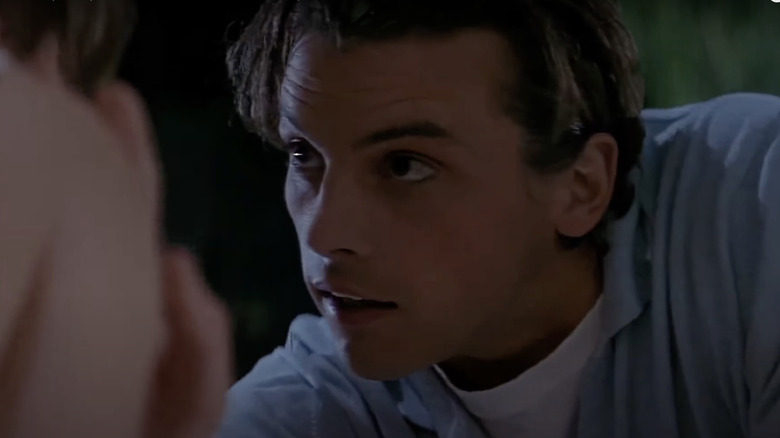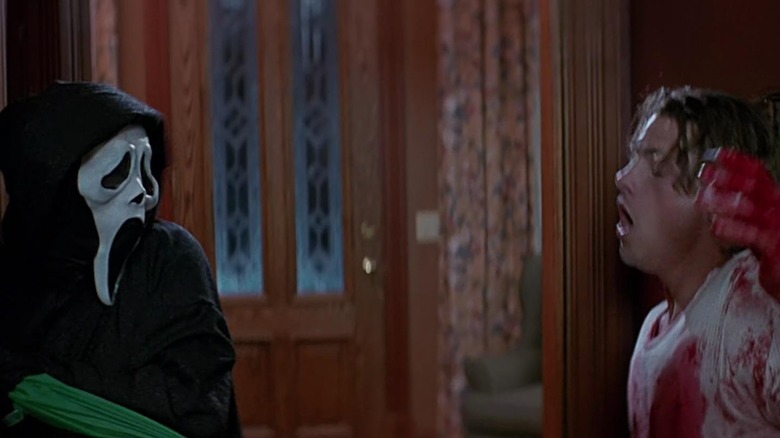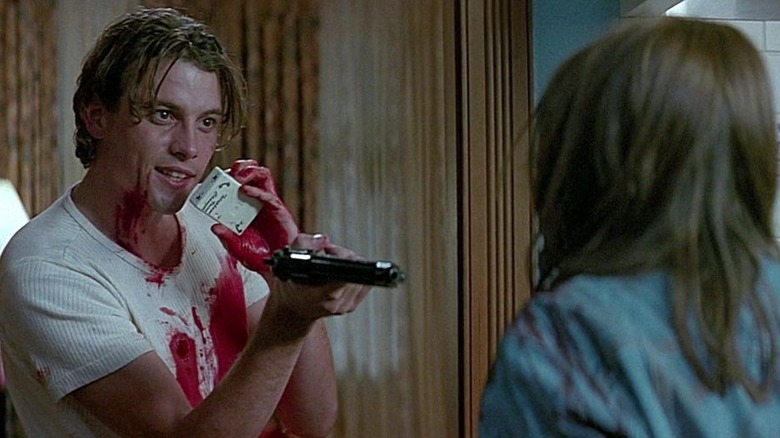An Accidental Stabbing In Scream Had Skeet Ulrich Experiencing Very Real Pain
A generally accepted truth amongst filmmakers is that making a horror movie is typically a light-hearted affair behind the scenes, given all the gore and traumatic mayhem happening while cameras are rolling. While that may be true, there's no doubt that making horror happen in front of those cameras requires a lot of blood, sweat and tears — and not always of the special-effects variety. Some of those substances can end up being very real, even unintentionally so.
Star Skeet Ulrich, director Wes Craven, and the rest of the cast and crew of 1996's "Scream" discovered this the hard way during the filming of one of the climactic scenes of the movie. When Ulrich's character, Billy Loomis (one half of the murderous duo known as Ghostface) is stabbed twice with an umbrella wielded by his girlfriend and the film's Final Girl, Sidney Prescott (Neve Campbell), one of the stabbings didn't quite hit the proper mark, and exacerbated an old wound Ulrich had, resulting in a scream of pain that was more real than reel.
In a fashion befitting John Travolta's sound technician from Brian De Palma's "Blow Out," Craven decided to keep the moment and the scream of pain in the final cut of the movie, resulting in the character's defeat feeling that much more truthful, and thereby better setting up the movie's punchline to the moment that shortly follows.
Ulrich vs. the umbrella
One of the reasons Ulrich suffered the injury on set is because, as part of the scene, Sidney (played in the shot by a stuntwoman and not Campbell) is wearing one of the Ghostface masks while she attacks Billy, making visibility an issue. During his commentary track for the film, Craven recalled the incident between Ulrich and the umbrella:
"Here's the inside story on this: Skeet, when he was 10 years old, had open heart surgery, and there's one place in his chest where there's a stainless steel wire, where if you touch it, it's excruciating. And we had him completely padded up on this, so that when he gets stabbed by this collapsing umbrella, he would be protected. And of course, the stuntwoman, because the mask is so difficult to see through, stabs him right on the spot and misses the pad entirely. [...] So it's a very real reaction."
There are a few layers of irony here; one, that Ulrich had a single specific place on his body he'd hoped could be avoided, and it wasn't. Two, that in a movie involving multiple killers doing dirty deeds with various pieces of cutlery, more people weren't injured from all the various other stabbings and slicings. And three, that despite all those sharp objects present and involved in the narrative, the biggest injury would come courtesy of an umbrella. Though perhaps that last point shouldn't be too surprising; as any horror fan knows from the likes of, for example, "Silent Night Deadly Night Part 2" and "Turbo Kid," umbrellas can do a heckuva lot of damage.
Craven constructs a devilishly clever finale
In different circumstances, a director would likely not use a take gone awry in the final cut of their movie. However, Craven not only understood that using Ulrich's real scream of pain would add to the intensity of the moment, but also knew that it would subconsciously help fool the audience into a false sense of security, believing that Billy was indeed dead before he suddenly pops back up and attacks Sidney all over again.
As Randy (Jamie Kennedy), the movie's resident horror geek, later warns Sidney: "This is the moment where the supposedly dead killer comes back to life," referencing a well-worn trope of the slasher movie established all the way back in John Carpenter's "Halloween." Knowing that Kevin Williamson's shrewd script explicitly references this trope, and wanting to utilize the movie's meta commentary on it to the fullest, Craven cleverly uses that real scream from Ulrich to further blur the line between fiction and reality. Sure, the audience may not know on a first watch that Ulrich is in actual pain during the scene, but they could subconsciously sense it, making Billy's "resurrection" that much more surprising when it happens, resulting in one kick-ass ending.
In any case, the moment is illustrative of just how much effort goes into making a classic horror film, as well as how tuned-in "Scream" is to looking at the blurred line between real life and the silver screen: at a certain point, that line is invisible.


